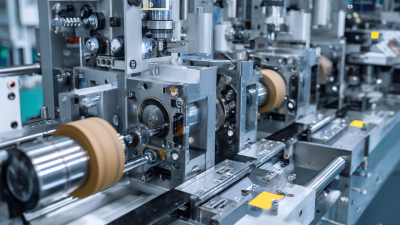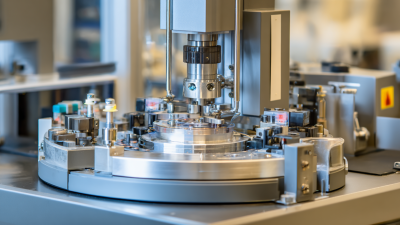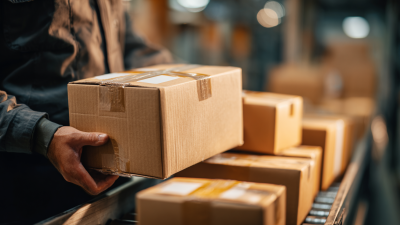Exploring the Future of Plastic Blister Packaging: Innovations and Sustainability Trends Behind 2023's Market Growth
As the world grapples with the pressing issue of sustainability, the packaging industry is experiencing a significant transformation, particularly in the domain of plastic blister packaging. This innovative form of packaging, renowned for its ability to protect and display products, is witnessing a marked evolution driven by both technological advancements and a growing demand for environmentally friendly solutions. In 2023, the market for plastic blister packaging is projected to flourish as companies seek to balance practicality with ecological responsibility.

This article aims to explore the various innovations and sustainability trends that are shaping the future of plastic blister packaging, offering insights into how manufacturers can adapt to meet consumer expectations while minimizing their environmental footprint. By examining these pivotal changes, we can better understand the path forward for this vital segment of the packaging industry.
Emerging Innovations in Plastic Blister Packaging: Key Technological Advancements of 2023
The plastic blister packaging market is witnessing significant advancements in technology that are driving its innovation and sustainability for 2023. One of the most notable trends is the integration of smart packaging solutions that not only enhance user experience but also improve product management. These solutions leverage electronic functionalities for condition monitoring and asset tracking, making packaging smarter and more efficient. This evolution aligns with the broader movement towards sustainable practices as manufacturers focus on reducing waste and increasing recyclability.
In addition, the pharmaceutical plastic packaging segment is projected to grow substantially, supported by developments such as advanced inspection technologies like x-ray and robotics. These innovations enhance the safety and efficacy of packaging, ensuring that pharmaceutical products meet stringent regulations. The shift towards a circular economy in plastics is also gaining momentum, with companies actively seeking to minimize their reliance on virgin materials and improve overall sustainability. As a result, the market is not only expanding in size but is also becoming more technologically advanced, paving the way for a greener future in packaging solutions.
Exploring Innovations in Plastic Blister Packaging
This chart illustrates the growth in various technological advancements in plastic blister packaging from 2021 to 2023, highlighting key innovations such as eco-friendly materials, automation in production, and enhanced design capabilities.
Sustainability Trends Impacting Blister Packaging: Analyzing Consumer Preferences and Market Demands
As consumers become increasingly aware of environmental issues, their preferences are significantly influencing the blister packaging market. The demand for sustainable materials is on the rise, pushing manufacturers to adopt eco-friendly alternatives. Brands are now prioritizing biodegradable and recyclable options to meet the criteria set by informed consumers. This transition not only helps protect the environment but also enhances brand loyalty among consumers who value sustainability.
**Tips for Brands: Embrace Transparency**
Consumers appreciate transparency in packaging. Brands should consider providing information on their packaging materials and recycling processes. This could be achieved through clear labeling or educational campaigns that inform customers about the sustainability efforts behind their packaging choices.
Furthermore, innovations in design are playing a crucial role in the market's evolution. With advancements in technology, companies are developing unique packaging solutions that minimize waste while maximizing functionality. For example, using thinner materials that still provide durability can significantly reduce plastic use.
**Tips for Consumers: Choose Mindfully**
When selecting products, consumers can make a positive impact by choosing items with sustainable packaging. Look for labels that indicate biodegradable or recyclable materials and support brands that prioritize environmental responsibility. Your purchasing power can drive meaningful change in the packaging industry.
Exploring the Future of Plastic Blister Packaging: Innovations and Sustainability Trends Behind 2023's Market Growth
| Dimension | Statistical Data | Trends | Consumer Preferences |
|---|---|---|---|
| Market Growth Rate (2023) | 8.5% | Increased demand for eco-friendly materials | 80% prefer biodegradable options |
| Recyclability Rate | 45% | Focus on recyclable blister designs | Consumers seek responsible packaging |
| Sustainable Material Adoption | 30% increase | Rise in plant-based plastics | 64% support innovation in packaging |
| Consumer Awareness | 75% | Growing awareness of plastic pollution | 67% prioritize sustainability over cost |
| Innovations in Design | 20% more multifunctional packaging | Integration of digital technology | 58% prefer interactive packaging solutions |
Market Growth Projections for Blister Packaging: Insights from Recent Industry Reports and Research
 The blister packaging market has shown substantial growth in recent years, fueled by ongoing innovations and a heightened emphasis on sustainability. According to recent industry reports, the market is projected to grow significantly, impacting various sectors including fast-moving consumer goods (FMCG) and pharmaceuticals. As brands increasingly adopt environmentally friendly practices, the shift towards sustainable packaging is becoming a cornerstone of market strategy, aligning with consumer preferences for responsible production methods.
The blister packaging market has shown substantial growth in recent years, fueled by ongoing innovations and a heightened emphasis on sustainability. According to recent industry reports, the market is projected to grow significantly, impacting various sectors including fast-moving consumer goods (FMCG) and pharmaceuticals. As brands increasingly adopt environmentally friendly practices, the shift towards sustainable packaging is becoming a cornerstone of market strategy, aligning with consumer preferences for responsible production methods.
Tips: When considering packaging options, focus on materials that are not only functional but also eco-friendly. Look for biodegradable or recyclable blister packaging solutions that meet your product requirements. Additionally, staying informed on emerging technologies, such as bioplastics sourced from renewable resources, can provide a competitive advantage in this evolving market landscape.
With the blister packaging market forecast to expand rapidly over the next decade, stakeholders should pay close attention to consumer trends and regulatory changes that may influence design and manufacturing processes. Companies that invest in innovation while prioritizing sustainability will not only meet market demands but also enhance their brand reputation among eco-conscious consumers.
Evaluating the Role of Eco-Friendly Materials in Future Blister Packaging Solutions
As the demand for environmentally responsible packaging continues to rise, the role of eco-friendly materials in blister packaging is becoming increasingly significant. According to a recent report from Smithers Pira, the global blister packaging market is projected to reach $57 billion by 2027, with sustainable materials playing a crucial part in this growth. Companies are now prioritizing materials such as biodegradable plastics and recycled content, emphasizing their commitment to reducing environmental impact.
Innovative solutions, such as the use of plant-based polymers and compostable films, are being explored to replace traditional petroleum-based plastics. For instance, a study by MarketsandMarkets revealed that the bio-based packaging segment is expected to grow at a CAGR of over 10% from 2023 to 2028. This trend is driven by both regulatory pressures and consumer preferences, prompting manufacturers to adopt greener practices.
By integrating eco-friendly materials into blister packaging, companies are not only enhancing their sustainability credentials but also tapping into the growing market of environmentally conscious consumers. The successful implementation of these materials demonstrates a significant shift towards a circular economy, where products are designed with their end-of-life outcomes in mind, thus reducing waste and promoting resource efficiency.
Competitive Landscape of the Blister Packaging Industry: Key Players Driving 2023 Developments
The competitive landscape of the blister packaging industry in 2023 sees significant transformations driven by key players focusing on innovation and sustainability. As the market for blister packaging is projected to reach approximately USD 49.57 billion by 2035, companies are investing heavily in developing materials that are both efficient and eco-friendly. The emphasis on sustainability is becoming increasingly important, with a growing demand for plastic alternatives and recyclable materials as consumers and regulatory bodies push for a circular economy.
Noteworthy advancements are evident in the healthcare segment, where aluminum continues to dominate with a significant market share. The forecast indicates that the healthcare blister packaging market will rise from USD 19.5 billion in 2023 to USD 41.7 billion by 2033, with a compound annual growth rate (CAGR) of 7.9%. Such growth reflects the industry's response to evolving market needs where safety, compliance, and environmental impact play crucial roles in the decision-making of packaging providers. As industry leaders adapt to these trends, the competition will likely intensify, fostering an environment ripe for innovative solutions that meet both performance and sustainability goals.

Related Posts
-

How to Optimize Your Blister Card Packaging for Enhanced Product Visibility and Sales Performance
-

7 Best Strategies to Optimize Your Blister Machine Investment
-

How to Select the Right Blister Packing Machine for Your Production Needs
-

How to Achieve Optimal Results with Blister Card Printing in Modern Packaging Design
-

Understanding the Role of Blister Packaging Machines in Modern Manufacturing Processes
-

Ultimate Guide to Mastering Clam Packaging for Global Buyers
